Anton Flettner
Anton Flettner (November 1, 1885 – December 29, 1961) was a German aviation engineer and inventor.[1] Born in Eddersheim (today a district of Hattersheim am Main), Flettner made important contributions to airplane, helicopter, vessel, and automobile designs.[1][2][3]
Anton Flettner | |
|---|---|
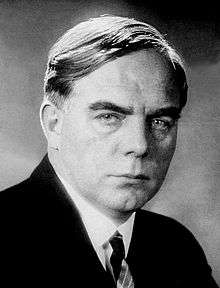 Anton Flettner | |
| Born | November 1, 1885 Hattersheim am Main, Germany |
| Died | December 29, 1961 (aged 76) |
| Nationality | Germany |
| Occupation | Engineer |
| Engineering career | |
| Discipline | Aviation Engineer, Inventor |
| Projects | Helicopters, Rotor Ships |
After serving Germany in both World Wars, Anton Flettner emigrated to the United States post World War II as a consultant to the office of Naval Research at the United States Navy.[4]
Anton Flettner attended the Fulda State Teachers College in Fulda, Germany.[5] He was the village teacher in Pfaffenwiesbach from 1906-1909.[4] Flettner subsequently taught high school mathematics and physics in Frankurt, where he developed ideas that would assist Germany in World War I.[5]
Flettner revolutionized the art of harnessing the wind, used essentially in an unaltered form for thousands of years—the canvas sail—by a modern machine—the Flettner Rotor ship—that could permit ocean liners to reduce their crews by two-thirds and save 90 percent in fuel.[6][7]
World War I
From 1914-1918 Anton Flettner worked at the German Ministry for War in the development of remote controls for air, water, and land vehicles.[8] While employed under the aegis of Graf Zeppelin, Flettner also developed pilotless aircraft projects.[1][9]
At the age of 29, Flettner presented his first invention, a steerable torpedo, to the Kriegsmarine (German Imperial Navy) of World War I.[2] This, and his next invention, a remote-controlled combat car, which was presented to the Heer (German Army), were rejected because they were not considered to be technically feasible.[2] However, Flettner's efforts culminated in the prototype Siemens Schuckert Werke 1000 kg wire guided air to surface missile of 1918.[9]
During World War I, Flettner developed the servo tab / anti-servo tab.[10] The servo tab evolved into the "trim tab" which is still in use on all airplanes and many large vessels.[1][10] Trim tabs are extremely useful in moving large rudders on vessels with vastly reduced power.[1][10]
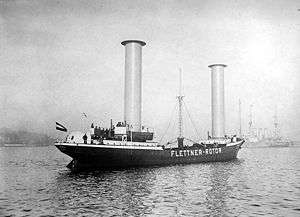
Post World War I
Following World War I, Flettner was named Managing Director of the Institute for Aero and Hydro Dynamics in Amsterdam.[4] He held that post until 1931.[4] In the 1920s, Flettner also invented the famous Flettner rotary ventilator, which was widely used on buses, vans, boats, railroad cars, campervans, and trucks to assist cooling without the use of energy.[2] Modern derivatives of his ventilator are still manufactured in Britain by Flettner Ventilator Limited.[2]
With assistance from Albert Betz (German physicist), Jakob Ackeret (Swiss aeronautical engineer), Ludwig Prandtl (German engineer), and Albert Einstein (German theoretical physicist), Anton Flettner constructed an experimental rotor vessel (Buckau later renamed the Baden-Baden) in October 1924 at the Friedrich Krupp Germaniawerft.[11] The Buckau was a schooner refitted with two rotating 50-foot cylinders and was the first vessel built with a propulsion system based on the Magnus effect.[11] Flettner came upon the idea while at the beach with his wife.[7] Flettner used sand, flowing over his rotating hand, to describe the Magnus effect and realized its potential for sail propulsion.[7] The Baden-Baden crossed the Atlantic in 1926.[4] It could outsail normal schooners under moderate to heavy winds, but it was destroyed by a storm in 1931.[12] A commercial ship, the Barbara Rotor ship, was also built and sailed to the United States.[12]
In 1926, Anton Flettner shifted his focus to aviation in founding his own company, the Anton Flettner Aircraft Corporation in Berlin, aiming at the application of the Flettner-rotor as a wing replacement on large wind turbines.[8][10] In 1935, Flettner built a German night reconnaissance and anti-submarine autogyro called the Fl 184.[10][13] Flettner followed this accomplishment by building the Flettner Fl 185 in 1936, an experimental German gyrodyne, which could fly as both a helicopter and as a gyroplane.[14]
In 1938 Flettner, together with Kurt Hohenemser, built the Flettner Fl 265.[2] The Flettner Fl 265 addressed the problem of torque compensation as the first helicopter with counter-rotating rotors (Flettner double rotor).[2]
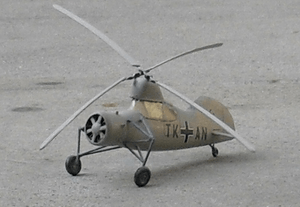
World War II
During World War II, Anton Flettner headed Flettner Flugzeubau GmbH, which specialized in reconnaissance helicopters for the German Luftwaffe (Air Force).[1]
Flettner's helicopter inventions were financed from wealth acquired from his ventilator business, a company that was enhanced by the skill of his wife, Lydia Freudenberg Flettner.[2] Anton Flettner built his helicopters for the German military, primarily for navy spotter use. Although his wife was Jewish,[15] he held a personal relationship with the head of gestapo, Heinrich Himmler. Himmler had Flettner's wife and family escorted safely to Sweden for the duration of the war.[15] Anton Flettner's partner and confidant was Dr. Kurt Hohenemser, a brilliant and thorough engineer who developed the details necessary for the success of Flettner's helicopters.[15] Dr. Hohenemser's father was also Jewish, yet both remained unharmed during their tenure together throughout the war as they worked to develop the helicopter for military use.[9][15]
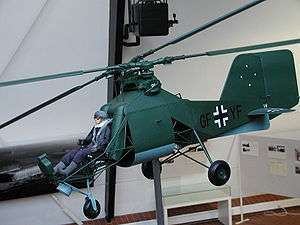
While the final product, the Flettner Fl 282 Kolibri ("Hummingbird"), could be factory-assembled, Flettner and Hohenemser insisted that they were the only ones who were capable of assembling the complex intermeshing rotor gearbox assembly.[1] Plans for mass production of 1,000 Flettner Fl 282 helicopters by BMW were disrupted when allied forces bombed the designated factory.[9]
At least two other Flettner helicopters were under development when World War II ended.[16] They were the Flettner Fl 285, another reconnaissance helicopter with a two-hour flight limit and capacity to carry two small bombs, and the Flettner Fl 339, a large transport helicopter project designed for approximately 20 passengers.[16]
Photo gallery
 Flettner Fl 282 Kolibri helicopter
Flettner Fl 282 Kolibri helicopter Letter from Dr. Hohenemser regarding his association with Anton Flettner (page 1 of 2)
Letter from Dr. Hohenemser regarding his association with Anton Flettner (page 1 of 2) Letter from Dr. Hohenemser regarding his association with Anton Flettner (page 2 of 2)
Letter from Dr. Hohenemser regarding his association with Anton Flettner (page 2 of 2)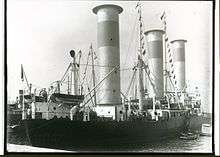 The rotor ship "Barbara"
The rotor ship "Barbara" Flettner's patent to a steering mechanism
Flettner's patent to a steering mechanism Flettner's boyhood home in Eddersheim, Germany. Anton Flettner is on the far right.
Flettner's boyhood home in Eddersheim, Germany. Anton Flettner is on the far right.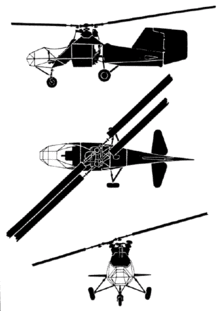 Flettner Fl 282 Kolibri
Flettner Fl 282 Kolibri- Tomb of Anton Flettner
 1931 photo of the Flettner-Krupp-Grosskraftwagen, the largest German truck, which is 15 tons. The payload and is 14 m long and it is powered by a 150 P.S. engine.
1931 photo of the Flettner-Krupp-Grosskraftwagen, the largest German truck, which is 15 tons. The payload and is 14 m long and it is powered by a 150 P.S. engine.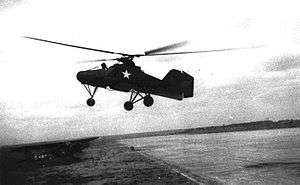 Flettner Fl 282 during flight trials after World War II, with US markings
Flettner Fl 282 during flight trials after World War II, with US markings
Post World War II
.jpg)
Upon the war's conclusion, Anton Flettner was held in the "Dustbin" interrogation camp at Kransberg Castle.[17] After 1945, Flettner, along with many other aviation pioneers, was brought to the United States as part of Operation Paperclip.[18] Flettner and his partner, Dr. Kurt Hohenemser, were among the first German emigrants into the United States after World War II.[19]
Flettner started Flettner Aircraft Corporation, which developed helicopters for the U.S. military.[1] In 1949, Flettner employed Kurt Hohenemser as a consultant to the Flettner Aircraft Corporation.[20] Flettner and Kurt Hohenemser, who together developed numerous patents in Germany, kept in close contact after both men emigrated to the United States.[20]
Flettner's company in the U.S. was not commercially successful, but his work was shared with the US Army Air Forces.[10] Throughout his 14 years in the United States, Flettner was active in carrying out research projects for the US Army, US Air Force, and the US Navy.[4]
Flettner became the chief designer of Kaman Aircraft and many of the Flettner design concepts are found in Kaman helicopters of later years.[8]
Today the Flettner rotor is in operation as a supplemental propulsion system for transport and research vessels.[21] There are two ships utilizing the concept of the Flettner rotor in a modified form, the turbosail Acyone developed by Jacques-Yves Cousteau in 1985 and the E-Ship 1, a cargo ship that made its first voyage in 2010.[2][22][23] Albert Einstein praised the Flettner Rotor ship as having great practical importance.[1]
Anton Flettner's colleague and former partner, Kurt Hohenemser, worked his remaining years in the United States to prove Flettner's idea that properly designed flexible helicopter-type rotors are more suitable for producing electricity from the wind than rigid airplane-type rotors.[19] An offshore wind energy project announced in February 2017, involving Seawind Ocean Technology B.V., aims to demonstrate the wind energy applications put forth by Anton Flettner, Kurt Hohenemser, and Glidden Doman (American aeronautical engineer) in harsh wind and sea conditions.[19][24][25]
Anton Flettner died at age 76 in New York City on December 29, 1961.[26] Among his many distinctions, Anton Flettner was an honorary member of the American Helicopter Society and the Convertible Aircraft Pioneers.[4] Flettner's birthplace home and tomb are national historic protected monuments in Germany.[2]
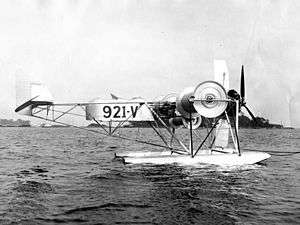
Aircraft built by Flettner Flugzeugbau GmbH
- Flettner Fl 184[27]
- Flettner Fl 185[27]
- Flettner Fl 265[27]
- Flettner Fl 282[27]
- Flettner Fl 285[27]
- Flettner Fl 339[27]
See also
- Autogyros
- Flettner ship, a schooner that derives its thrust using the Magnus effect
- Flettner airplane, an airplane that derives its lift using the Magnus effect
- Flettner Fl 184 helicopter-gyroplane hybrid
- Flettner Fl 185 helicopter
- Flettner Fl 265 helicopter
- Flettner Fl 282 "Kolibri" helicopter
- Flettner ventilator
- Gyrodynes and Heliplanes
- Charles Kaman
References
- "Anton Flettner". The New York Times (Obituary). December 30, 1961.
- "FLETTNER, Anton aus Eddersheim am Main". duchmann.net. Duchmann.
- "Flettner Ventilator". flettner.co.uk.
- Graven, Eric. "Anton Flettner". Helis.com. The New York Times.
- Lepage, Jean-Denis G.G. (February 5, 2009). Aircraft of the Luftwaffe, 1935D1945: An Illustrated Guide. McFarland. pp. 23–24. ISBN 978-0786439379.
- "Mein Weg zum Rotor". abebooks.com. F.O. Willhoft.
- Seybold, G.B. "A Sailing Ship Without Sails: New Wonder of the Seas". Popular Science Monthly. February 1925.
- Hirschel, Ernst Heinrich; Prem, Horst; Madelung, Gero (2012-12-06). Aeronautical Research in Germany: From Lilienthal until Today. Springer. ISBN 9783642184840.
- "Flettner Fl 282 "Kolibri" 1940". aviastar.org. Aviastar.
- "Anton Flettner". NEAM.
- "History of windpower". Thiiink.com.
- "Anton Flettner's first rotor ship, the Baden-Baden, crossed the Atlantic in 1926". Researchgate.net. ResearchGate.
- "Flettner Fl 184 reconnaissance helicopter, prototype". newingtonwarmuseum.com. Newington War Museum.
- "Flettner.Fl 185 1938". aviastar.org. Aviastar.
- "The Flettner Fl-282 V21 Kolibri". Skynet Airplanes.
- "Flettner Fl 285". All-Aero.com. All Aero.
- "Project Paperclip". Conflict Matrix. Retrieved December 5, 2013.
- Boyne, Walter J. (2011). How the Helicopter Changed Modern Warfare. Pelican Publishing. p. 45. ISBN 978-1-58980-700-6.
- Martin, Douglas. "Kurt Hohenemser, Early Helicopter Designer, Dies at 95". New York Times. The New York Times. Retrieved April 21, 2001.
- Glover, Sarah; Rieg-Baumhauer, Felix. "Guide to the Kurt Hohenemser Collection undated, 1885-2007 (bulk 1931-2001)". Leo Back Institute Center for Jewish History. Leo Baeck Institute.
- "Flettner Rotors". Deutsches Museum. Archived from the original on 2016-12-07. Retrieved 2017-02-28.
- "Turbosail Cousteau Society". cousteau.org. Cousteau. Archived from the original on 2013-12-18.
- Gerke, Thomas. "E-Ship 1 - 21st-Century Sailing". cleantechnica.com. Clean Technica. Retrieved April 10, 2012.
- "Seawind, Olav Olsen to Jointly Bring Forward 6.2 MW Demo Project". offshoreWIND.biz.
- Jakubowski, Martin. "Seawind History". Seawind Technology. Seawind. Archived from the original on February 15, 2017. Retrieved January 17, 2017.
- Anton Flettner; Hubschraubermuseum Bückeburg
- "Flettner Flugzeugbau GmbH". Wehrmacht History.
External links
| Wikimedia Commons has media related to Anton Flettner. |